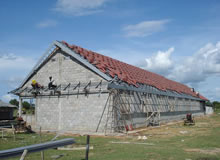
| Establishment | 2010/12/2 |
| Student Numbers | 162(2012/2) |
| Commune | Banteay Meanchey Province, Malai District, Tuol Pongro (Population:10,081 Number of Households:2,103) ※Population・Number of Households (Source: General Population Census of Cambodia 2008) |
| Supports | Y’s Men International Osaka Nichi Club, DATA MAX Co, Ltd. Rotary Club of Osaka Joto |
Background

Malai district, Banteay Meanchey province is just a few kilometres from the Cambodian Thai border and was a fierce battlefield among the Khmer Rouge, the anti-communist government and the Vietnamese army during the civil war. The area is known to be the most mine affected region in the country. Whilst the net enrolment rate in primary education in Cambodia has reached more than 95%, there is a huge gap between urban and rural secondary education. In Malai district, the secondary school attendance rate is only 24% and the figure is relatively lower than the national average.
Mine Clearance

『M11204A Minefield』is where the Tuol Pongro commune provided land for the construction of a future CMC school. After several meetings and discussions with multiple stakeholders, the construction of school began in December 2009.
Open a school

On the 2nd October, 2012, Tuol Pongro Miotsukushi lower secondary school opened with 10 classrooms in two different buildings. The number of mines/ERW cleared for this project were around 230. For the opening ceremony, Cambodia Senior Minister and our sponsors; The Y’s Men’s Club of Osaka Nishi and Data Max Co., Ltd were invited.

| Establishment | 2008/9/26 |
| Student Numbers | 115(2012/2) |
| Commune | Banteay Meanchey Province, Ou Chrov District, Koub (Population:7,859 Number of Households:1,616) ※Population・Number of Households (Source: General Population Census of Cambodia 2008) |
| Supports | Junior Chamber International Japan Sasebo, Himawari-kai |
Background

In 2008, the primary school enrolment rate in Koun Trei village was 82.5%, however the secondary school was 3.9% which was extremely low (Hiromi Ueda, 2006). The nearest secondary school was 20 kilometres away from the village so that most of the children who graduated primary school could not easily access secondary education. In order to improve the situation, the CMC decided to work collaboratively with the Junior Chamber International Sasebo.
Mine Clearance

During the civil war Koun Trei village became a battlefield and is still categorised as a mine affected area even though some clearance operations by the CMAC (Cambodia Mine Action Centre) had carried out more than 10 years ago. It is not entirely rare that mines/ERW are found on private property.
Open a school

The new school opened on the 26th of September, 2008. The project had been delayed due to the global market fluctuations that hit the Cambodian construction industry.
Opening ceremony

After the four-month construction period, The Ministry of Education in Cambodia, the Junior Chamber International Sasebo and the CMC were invited to the school opening ceremony and shared a great moment with the children. At the same time, Mr Otani(the president), has received the National Contribution Award from the Cambodian government.
Gardening Project

A well-known Japanese gardener, Mr. Kazuyuki Ishihara, has contributed to the school gardening project in Koun Trei. The school has become a very cheerful place due to the effect of the green trees and colourful flowers which have been added to the school.

| Establishment | 2004/7/5 |
| Student Numbers | 150(2012/2) |
| Commune | Battambang Province, Moung Russei District, Moung (Population:15,405 Number of Households:3,073) ※Population・Number of Households (Source: General Population Census of Cambodia 2008) |
| Supports | Mr. Abe(a priest at a Buddhist temple), ITOCHU Corporation |
Background

Boh Puoy village was a fierce battlefield between the Khmer Rouge and the Cambodian government during the civil war. In 2004, a large number of mines had been left behind in the village and people have lived under poor conditions with no gas, electricity and water supplies. The existing primary school is without proper roofing, which has made it difficult for children to study during the rainy season. The CMC has decided to build a concrete school building in Boh Puoy in order to provide a better learning environment for local children.
Mine Clearance

At this stage, mine clearance operations have begun. The CMAC combed over the 71.814 square meters of field with metal detectors and found 78 mines and ERW in two and a half months of clearance work. Whilst these weapons found in the vicinity of school, residential areas and roads have been cleared, some other parts of the village are still danger zones.
Construction

The construction began in March 2004. The school’s only male teacher Youn kindly participated in making chairs and desks. Meanwhile, the CMC constructed a reservoir for villagers’ daily use and a water tank for keeping safe water. The issue of teacher absence has improved by addition of new staff accommodation.
Open a school

The CMC Boh Puoy Abe Primary school opened in July 2004. In the ceremony, the representative of Battambang State and Mr. Miyahara, a chief correspondent of the Nishi Nihon newspaper, were also invited as guests. The CMC has received a lot of great support from all over Japan, especially Mr. Abe (– 29 March, 2005), a priest at a Buddhist temple in Fukushima prefecture, who gave massive financial assistance for this school project. His strong passion towards the international cooperation has been passed on to students in Boh Puoy primary school.
Boh Puoy Primary School at present

In March 2012, Mr Abe’s memorial ceremony was held in the school. The village often suffers from severe droughts and floods so that the main agriculture, which is centred on rice production, is almost impossible to maintain in this area. Because of that many of villagers become seasonal migrant labour and travel to Thailand with their family in the rainy season. The biggest concern is that a large number of children still cannot receive a proper education. The CMC has worked on several different challenges such as agricultural training to increase crop harvests, though further assistance is still necessary.









